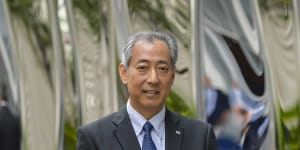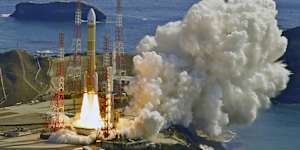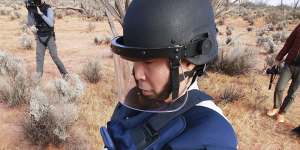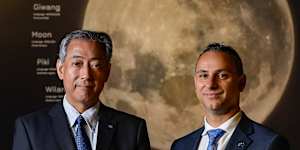Fourteen minutes after liftoff,Japan’s space agency issued a self-destruct command. The rocket,which cost 200 billion yen ($2.2 billion) to develop,rained down in pieces off the coast of the Philippines. The second-stage engine had failed to ignite.

Dr Hiroshi Yamakawa,President of the Japan Aerospace Exploration Agency,at Adelaide’s Space Discovery Centre.Roy Van Der Vegt
“Space is hard,” president of the Japan Aerospace Exploration Agency (JAXA),Dr Hiroshi Yamakawa,said. “If we repeat the same technology every year,it’s not so hard. But we,especially space agencies,are always tackling new technologies and engaging in new missions.
“Our role is to maintain accessibility to space. That is our vital mission. Right now all we have to do is move on,move forward.”
The H3 rocket is the latest costly carnage in the new space race. Last month,the first private lunar landing attempted by Japanese company ispace failed after a likely crash on the moon,a few days after SpaceX’s Starship test launch.
But that’s the cost of building an industry forecast to be worth $1 trillion by 2040. Yamakawa is a guest of the Australian Space Agency (ASA),which aims to build Australia’s space industry to $12 billion,with 30,000 jobs,by 2030.

The H3 rocket launched successfully in Japan but self-destructed in space,setting back JAXA’s exploration plans.AP
Yamakawa will attend Tuesday’s Space Forum,a biannual gathering of Australian space companies in Adelaide,with a trade delegation from Japan.
On the agenda for discussion is the next collaboration between JAXA and the ASA,which will see a capsule containing Martian moon samples crash-land in the South Australian outback as part of Japan’s Martian Moons eXploration (MMX) mission.
“MMX will be the world’s first mission to recover soil samples from the Martian sphere,” Yamakawa said. “They’ll provide great insight into the origin of Mars and the Martian moon itself,but also of the solar system.”
JAXA is investigating how Australia could help analyse the lunar soil from one of Mars’ moons,Phobos,which is due to land in 2029,although the launch date for the MMX mission could be affected by the H3 failure.

A capsule containing fragments from Ryugu asteroid dropped near Woomera in 2020 after a multibillion-kilometre voyage.AP
The mission follows on from JAXA and ASA’s last collaboration,which saw samples collected from the Ryugu asteroid land near Woomera in South Australia.
“We often think about what are our unfair advantages as a space sector in Australia,and one of those is our geography,” ASA chief Enrico Palermo said. “In 2020 we saw the Hayabusa2 capsule return to Earth after taking samples from a 4.7 billion-year-old asteroid.”
Analysis of material from Ryugu showed the asteroid fragments contained water and 23 amino acids,Yamakawa said,adding key evidence to the hypothesis that the ingredients that made life on Earth possible may have.

Dr Yamakawa and head of the Australian Space Agency Enrico Palermo.Roy Van Der Vegt
While in Adelaide,Yamakawa has toured the Australian Space Discovery Centre and visited the University of Adelaide’s Plants in Space program,where Australian researchers are contributing to an international effort to grow plants in space to support long-duration habitation beyond Earth’s atmosphere.
“If you can do that in space,in the harshest environment,you can develop technologies that here on Earth can address challenges around food security,” Palermo said.
“As we invest in space,we always look to return that back to benefits here on Earth.”
JAXA is one of the space agencies contributing to the “Lunar Gateway”,a proposed space station that will orbit the moon as part of NASA’s Artemis moon landing mission. Yamakawa added he wanted to see more cooperation between Australia and Japan’s private space sectors.
“Space[research] is very important because it will contribute to not only Earth science but also space science,[which] will make way to expand the human presence beyond low Earth orbit,” Yamakawa said.
“I’m talking about the moon and beyond.”
The Morning Edition newsletter is our guide to the day’s most important and interesting stories,analysis and insights..